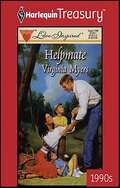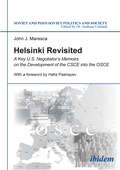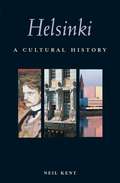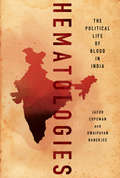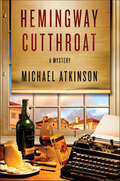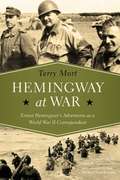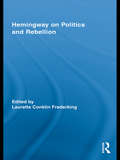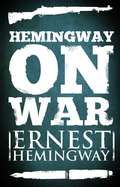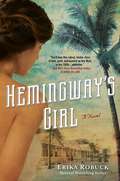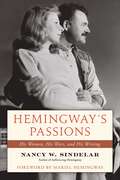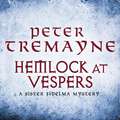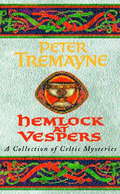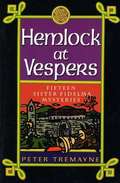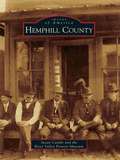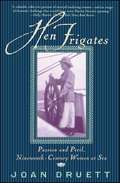- Table View
- List View
Helpmate
by Virginia MyersSO MANY BLESSINGS...SO LITTLE TIMEWife. Businesswoman. Mother of three. Jill Rhys enjoyed so many blessings-above all the deep love of her husband Greg, and their boisterous brood.Then, at the hospital bedside of her youngest child, Jill realized that she could lose it all in the blink of an eye. And she prayed to heaven for one more chance to cherish and protect their precious gift of love....The Bennett Women: Jill, Kate and Beth-three special women whose lives are brightened by faith-and hearts are won by true love!
Helsinki Revisited: A Key U.S. Negotiator's Memoirs on the Development of the CSCE into the OSCE (Soviet and Post-Soviet Politics and Society #150)
by John MarescaThe Helsinki Final Act of 1975 set in motion the legitimate, peaceful redrawing of national boundaries in many postcommunist countries—a triumph for pluralist democracy, the market economy, and personal freedom. Today, this policy serves as a diplomatic template for the proper handling of the current situation in Ukraine and crises in other regions of the former Soviet Union. A senior U.S. diplomat who operated at the center of these negotiations, John J. Maresca presents in this volume his personal recollections of the Helsinki Accords and the events that resulted in subsequent agreements.
Helsinki: A Cultural History (Interlink Cultural Histories)
by Neil KentHelsinki is one of the world's most northerly capitals, but it is by no means a city frozen in northern wastes. Situated along the southern shore of the Gulf of Finland, magnificent lakes and forests reach into Helsinki's urban heart, a rare event in today's world of suburban sprawl. Through such differing cultural phenomena as saunas, railway stations and tango, Neil Kent explains why Helsinki is a distinctive mix of tradition and innovation.
Hematologies: The Political Life of Blood in India
by Jacob Copeman Dwaipayan BanerjeeIn this ground-breaking account of the political economy and cultural meaning of blood in contemporary India, Jacob Copeman and Dwaipayan Banerjee examine how the giving and receiving of blood has shaped social and political life. Hematologies traces how the substance congeals political ideologies, biomedical rationalities, and activist practices.Using examples from anti-colonial appeals to blood sacrifice as a political philosophy to contemporary portraits of political leaders drawn with blood, from the use of the substance by Bhopali children as a material of activism to biomedical anxieties and aporias about the excess and lack of donation, Hematologies broaches how political life in India has been shaped through the use of blood and through contestations about blood. As such, the authors offer new entryways into thinking about politics and economy through a "bloodscape of difference": different sovereignties; different proportionalities; and different temporalities. These entryways allow the authors to explore the relation between blood's utopic flows and political clottings as it moves through time and space, conjuring new kinds of social collectivities while reanimating older forms, and always in a reflexive relation to norms that guide its proper flow.
Hemingway Cutthroat: A Mystery (Ernest Hemingway Mysteries)
by Michael AtkinsonThere were no bullfights in 1937 Madrid, just bombs, freedom fighters, journalists, and plenty of corpses. Ernest Hemingway, covering the Spanish Civil War for the American press, came looking for stories and danger, and found something else: a friend murdered amid the ruins. With a new novel stirring in his head and his veins pumping with booze, Hemingway sets out to find who killed José Robles Pazos, a bureaucrat in the Popular Front, and who's covering it up. There is, after all, nothing like risking death in a war zone if it means living fast, nailing the bastards, and avoiding a deadline. With the writer John Dos Passos at his side, Hemingway wades into the darkness, discovering that his old WWI buddy is no mere casualty of war---but victim of something far more terrible. Boisterous, bare knuckled, and stewed to the gills, Hemingway Cutthroat captures the writer at the height of his career and in a Europe teetering on untold cataclysm, struggling to find out not just for whom, but why the bell tolled.
Hemingway Deadlights: A Mystery (Ernest Hemingway Mysteries)
by Michael AtkinsonA witty, literate, and action-filled debut, Hemingway Deadlights catches the famed author in his later years, battling to solve the injustices in a flawed world.It is 1956 and Hemingway has spent much of the year at his home in Key West, hiding from tourists and autograph hunters. But a friend's sudden death rouses Papa from his idyll. To say that the cause of death is suspicious is to put it lightly. It's not every day that a part-time smuggler is impaled on a harpoon. "Neatly captures the personality and uproarious lifestyle of an American literary icon. ... A mystery sure to please Hemingway aficionados." - Publishers Weekly
Hemingway and the Spanish Civil War: The Distant Sound of Battle
by Gilbert H. MullerDuring the 1930s, no event was more absorbing or galvanizing to Ernest Hemingway than the Spanish Civil War. Hemingway was passionately devoted to the cause of the democratically elected Spanish Republic and he spent much of the war reporting from its front lines, producing a deeply political body of work that illuminated the conflict and presaged the world war to come. In the end, his immersive journey into the turbulent world of the Spanish Civil War resulted in For Whom the Bell Tolls, a landmark in American political fiction. This book offers a fresh account of Hemingway’s adventures in Spain during the Civil War, stressing his embrace of radical political action and discourse in defense of the Republic against the forces of Fascism. On the eightieth anniversary of For Whom the Bell Tolls, Gilbert H. Muller reconsiders Hemingway as an engaged artist, political actor, and visionary.
Hemingway at War: Ernest Hemingway's Adventures as a World War II Correspondent
by Terry MortFrom Omaha Beach on D-Day and the French Resistance to the tragedy of Huertgen Forest and the Liberation of Paris, this is the story of Ernest Hemingway's adventures in journalism during World War II. In the spring of 1944, Hemingway traveled to London and then to France to cover World War II for Colliers Magazine. Obviously he was a little late in arriving. Why did he go? He had resisted this kind of journalism for much of the early period of the war, but when he finally decided to go, he threw himself into the thick of events and so became a conduit to understanding some of the major events and characters of the war. He flew missions with the RAF (in part to gather material for a novel); he went on a landing craft on Omaha Beach on D-Day; he went on to involve himself in the French Resistance forces in France and famously rode into the still dangerous streets of liberated Paris. And he was at the German Siegfried line for the horrendous killing ground of the Huertgen Forest, in which his favored 22nd Regiment lost nearly man they sent into the fight. After that tragedy, it came to be argued, he was never the same. This invigorating narrative is also, in a parallel fashion, an investigation into Hemingway’s subsequent work—much of it stemming from his wartime experience—which shaped the latter stages of his career in dramatic fashion.
Hemingway on Politics and Rebellion (Routledge Studies in Social and Political Thought)
by Lauretta Conklin FrederkingHemingway has been labeled a ‘communist sympathizer,’ ‘elitist’, and a ‘rugged individualist.’ This volume embraces the complexity of political advocacy in Hemingway’s novels and short stories. Hemingway’s characters physically, intellectually and spiritually become part of resisting current conditions and affirm the value of resistance, even destruction, regardless of political outcome. Much more than political nihilism, rebellion allows man to realize the potentialities of his greatness as a leader, the realities of his solidarity as a comrade, and the simple sensations of everyday living. Hemingway draws new perspectives on the meaning of politics in our own lives at the same time as his writings affirm boundaries of political thought and literary theory for explaining many of the themes we study.
Hemingway on War
by Ernest HemingwayErnest Hemingway witnessed many of the seminal conflicts of the twentieth century--from his post as a Red Cross ambulance driver during World War I to his nearly twenty-five years as a war correspondent for The Toronto Star--and he recorded them with matchless power. This landmark volume brings together Hemingway's most important and timeless writings about the nature of human combat. Passages from his beloved World War I novel, A Farewell to Arms, and For Whom the Bell Tolls, about the Spanish Civil War, offer an unparalleled portrayal of the physical and psychological impact of war and its aftermath. Selections from Across the River and into the Trees vividly evoke an emotionally scarred career soldier in the twilight of life as he reflects on the nature of war. Classic short stories, such as "In Another Country" and "The Butterfly and the Tank," stand alongside excerpts from Hemingway's first book of short stories, In Our Time, and his only full-length play, The Fifth Column. With captivating selections from Hemingway's journalism--from his coverage of the Greco-Turkish War of 1919-22 to a legendary early interview with Mussolini to his jolting eyewitness account of the Allied invasion of Normandy on June 6, 1944--Hemingway on War collects the author's most penetrating chronicles of perseverance and defeat, courage and fear, and love and loss in the midst of modern warfare.
Hemingway on War
by Ernest HemingwayErnest Hemingway witnessed many of the seminal conflicts of the twentieth century—from his post as a Red Cross ambulance driver during World War I to his nearly twenty-five years as a war correspondent for The Toronto Star—and he recorded them with matchless power. This landmark volume brings together Hemingway’s most important and timeless writings about the nature of human combat. Passages from his beloved World War I novel, A Farewell to Arms, and For Whom the Bell Tolls, about the Spanish Civil War, offer an unparalleled portrayal of the physical and psychological impact of war and its aftermath. Selections from Across the River and into the Trees vividly evoke an emotionally scarred career soldier in the twilight of life as he reflects on the nature of war. Classic short stories, such as “In Another Country” and “The Butterfly and the Tank,” stand alongside excerpts from Hemingway’s first book of short stories, In Our Time, and his only full-length play, The Fifth Column. With captivating selections from Hemingway’s journalism—from his coverage of the Greco-Turkish War of 1919–22 to a legendary early interview with Mussolini to his jolting eyewitness account of the Allied invasion of Normandy on June 6, 1944—Hemingway on War collects the author’s most penetrating chronicles of perseverance and defeat, courage and fear, and love and loss in the midst of modern warfare.
Hemingway's Girl
by Erika Robuck"She remembered when Hemingway had planted a banyan tree at his house and told her its parasitic roots were like human desire. At the time she'd thought it romantic. She hadn't understood his warning."In Depression-era Key West, Mariella Bennet, the daughter of an American fisherman and a Cuban woman, knows hunger. Her struggle to support her family following her father's death leads her to a bar and bordello, where she bets on a risky boxing match...and attracts the interest of two men: world-famous writer, Ernest Hemingway, and Gavin Murray, one of the WWI veterans who are laboring to build the Overseas Highway. When Mariella is hired as a maid by Hemingway's second wife, Pauline, she enters a rarified world of lavish, celebrity-filled dinner parties and elaborate off-island excursions. As she becomes caught up in the tensions and excesses of the Hemingway household, the attentions of the larger-than-life writer become a dangerous temptation...even as straightforward Gavin Murray draws her back to what matters most. Will she cross an invisible line with the volatile Hemingway, or find a way to claim her own dreams? As a massive hurricane bears down on Key West, Mariella faces some harsh truths...and the possibility of losing everything she loves.
Hemingway's Havana: A Reflection of the Writer's Life in Cuba
by Robert Wheeler América FuentesErnest Hemingway lived in Cuba for more than two decades, longer than anywhere else. He bought a home—naming it the Finca Vigia—with his third wife, Martha Gellhorn and wrote his masterpiece The Old Man and the Sea there. In Cuba, Papa Hemingway found a sense of serenity and enrichment that he couldn’t find anywhere else. Now, through more than a hundred color photographs and accompanying text, Robert Wheeler takes us through the streets and near the water’s edge of Havana, and closer to the relationship Hemingway shared with the Cuban people, their landscape, their politics, and their culture. Wheeler has followed Hemingway’s path across continents—from La Closerie des Lilas Café in Paris to Sloppy Joe’s Bar in Key West to El Floridita in Havana—seeking to capture through photography and the written word the essence of one of the greatest writers in the English language. In Hemingway’s Havana, he reveals the beauty and the allure of Cuba, an island nation whose deep connection with the sea came to fascinate and inspire the writer. The book includes a foreword by América Fuentes who is the granddaughter of the late Gregorio Fuentes, the captain of Hemingway’s boat Pilar and his loyal and close friend.
Hemingway's Paris: A Writer's City in Words and Images
by Robert WheelerWalk through the Streets of Paris with Ernest Hemingway. In gorgeous black and white images, Hemingway’s Paris depicts a story of remarkable passion--for a city, a woman, and a time. No other city in any of his travels was as significant, professionally or emotionally, as was Paris. And it remains there, all of the complexity, beauty, and intrigue that Hemingway described in the pages of so much of his work. It is all still there for the reader and traveler to experience--the history, the streets, and the city. Restaurants, hotels, homes, sites and favorite bars are all detailed here. The ninety-five black and white photographs in Hemingway’s Paris are of the highest caliber. The accompanying text reveals Wheeler’s deep understanding of the man; his torment, talent, obstacles and the places of refuge needed to nurture one of the preeminent writers of the twentieth century. Moved by the humanistic writing of the man--a writer capable of transcending his readers to foreign settings and into the hearts and minds of his protagonists--Wheeler was inspired to travel throughout France, Italy, Spain, Africa, and Cuba, where he has sought to gain insight into the motivation behind Hemingway’s books and short stories. As a teacher, lecturer, and photojournalist, he set out to capture and interpret the Paris that Ernest Hemingway experienced in the first part of the century. Through his journal and photographs, Wheeler portrays the intimate connection Hemingway had with the woman he never stopped loving, Hadley, and with the city he loved most, Paris.
Hemingway's Passions: His Women, His Wars, and His Writing
by Nancy W. SindelarA provocative and unique look at how the women Hemingway loved shaped this literary legend Ernest Hemingway&’s passion was writing, and he was inspired by a lifetime of daring adventures and encouraged by the many women in his life. He nurtured his creativity by purposely seeking dangerous situations to test his own levels of courage and to create literary heroes who displayed grace under pressure. His masculine, adventurous spirit appealed to women of all ages, including four wives and a long list of legendary actresses, and he frequently transformed the women in his life into memorable fictional characters.In 1950, Hemingway told Marlene Dietrich that he truly loved only five women. Who were these women and why did he love them? Some of them may have included his wives—Hadley Richardson, Pauline Pfeiffer, Martha Gellhorn, and Mary Welsh—but there were others too, among them Agnes von Kurowsky. Through quotations from his works and personal letters, as well as more than sixty photographs—many of which have not been previously published—Hemingway scholar Nancy W. Sindelar captures Hemingway&’s life and romantic adventures, revealing his own feelings about his romantic relationships and the ways his experiences with women appear in his literary works.Much has been written about Hemingway, but to date no book has linked the women he loved to his written work. The stories of Hemingway&’s romantic relationships reveal not only the influence these women had on his writing but also his personal ambition, heartbreak, and literary triumphs and trials. Sindelar&’s provocative analyses of Hemingway&’s literature give fresh insight into the life of a legendary author, outdoorsman, adventurer, and lover.Includes 60 photographs, many never previously published.
Hemingway's Sun Valley: Local Stories behind His Code, Characters and Crisis
by Phil HussA Hemingway expert shares untold stories of the writer&’s life in Idaho, together with passages from his works, to shed light on the ideals he lived by. It was a cold, "windless, blue sky day" in the fall of 1939 near Silver Creek—a blue-ribbon trout stream south of Sun Valley. Ernest Hemingway flushed three mallards and got each duck with three pulls. He spent the morning working on his novel For Whom the Bell Tolls. Local hunting guide Bud Purdy attested, "You could have given him a million dollars and he wouldn't have been any happier." In Hemingway&’s Sun Valley, Phil Huss delves into previously unpublished stories about Hemingway's adventures in Idaho. Each chapter is devoted to a principle of the author's Heroic Code, such as Complete Tasks Well, Embrace the Present, and Avoid Self-Pity. Combining true stories and literary passages, this book reveals how Hemingway&’s life and work embody this code.
Hemingway's Widow: The Life and Legacy of Mary Welsh Hemingway
by Timothy ChristianA stunning portrait of the complicated woman who becomes Ernest Hemingway's fourth wife, tracing her adventures before she meets Ernest, exploring the tumultuous years of their marriage, and evoking her merry widowhood as she shapes Hemingway's literary legacy.Mary Welsh, a celebrated wartime journalist during the London Blitz and the liberation of Paris, meets Ernest Hemingway in May 1944. He becomes so infatuated with Mary that he asks her to marry him the third time they meet—although they are married to other people. Eventually, she succumbs to Ernest's campaign, and in the last days of the war joined him at his estate in Cuba. Through Mary's eyes, we see Ernest Hemingway in a fresh light. Their turbulent marriage survives his cruelty and abuse, perhaps because of their sexual compatibility and her essential contribution to his writing. She reads and types his work each day—and makes plot suggestions. She becomes crucial to his work and he depends upon her critical reading of his work to know if he has it right. We watch the Hemingways as they travel to the ski country of the Dolomites, commute to Harry's Bar in Venice; attend bullfights in Pamplona and Madrid; go on safari in Kenya in the thick of the Mau Mau Rebellion; and fish the blue waters of the gulf stream off Cuba in Ernest's beloved boat Pilar. We see Ernest fall in love with a teenaged Italian countess and wonder at Mary's tolerance of the affair. We witness Ernest's sad decline and Mary's efforts to avoid the stigma of suicide by claiming his death was an accident. In the years following Ernest's death, Mary devotes herself to his literary legacy, negotiating with Castro to reclaim Ernest's manuscripts from Cuba, publishing one-third of his work posthumously. She supervises Carlos Baker's biography of Ernest, sues A. E. Hotchner to try and prevent him from telling the story of Ernest's mental decline, and spends years writing her memoir in her penthouse overlooking the New York skyline. Her story is one of an opinionated woman who smokes Camels, drinks gin, swears like a man, sings like Edith Piaf, loves passionately, and experiments with gender fluidity in her extraordinary life with Ernest. This true story reads like a novel—and the reader will be hard pressed not to fall for Mary.
Hemingway's Widow: The Life and Legacy of Mary Welsh Hemingway
by Timothy ChristianA stunning portrait of the complicated woman who was Ernest Hemingway’s fourth wife, exploring the tumultuous years of their marriage, and evoking her merry widowhood as she shapes Hemingway’s literary legacy.Mary Welsh, a celebrated wartime journalist during the London Blitz and the liberation of Paris, meets Ernest Hemingway in May 1944. He becomes so infatuated with Mary that he asks her to marry him the third time they meet, even though they are married to other people. Eventually, she succumbs to Ernest’s campaign and, in the last days of the war, joins him at his estate in Cuba.Through Mary’s eyes, we see Ernest Hemingway in a fresh light. Their turbulent marriage survives his cruelty and abuse, perhaps because of their sexual compatibility and her essential contribution to his writing. She reads and types his work each day and makes plot suggestions. She becomes crucial to his work and he depends upon her critical reading of his writing to know if he has it right.We watch the Hemingways as they travel to the ski country of the Dolomites; commute to Harry’s Bar in Venice; attend bullfights in Pamplona and Madrid; go on safari in Kenya in the thick of the Mau Mau rebellion; and fish the blue waters of the gulf stream off Cuba in Ernest’s beloved boat Pilar. We see Ernest fall in love with a teenaged Italian countess and wonder at Mary’s tolerance of the affair.We witness Ernest’s sad decline and Mary’s efforts to avoid the stigma of suicide by claiming his death was an accident. In the years following Ernest’s death, Mary devotes herself to his literary legacy, negotiating with Castro to reclaim Ernest’s manuscripts from Cuba and publishing one-third of his work posthumously. She supervises Carlos Baker’s biography of Ernest, sues A.E. Hotchner to try and prevent him from telling the story of Ernest’s mental decline, and spends years writing her memoir in her penthouse overlooking the New York skyline.Her story is one of an opinionated woman who smokes Camels, drinks gin, swears like a man, sings like Edith Piaf, loves passionately, and experiments with gender fluidity in her extraordinary life with Ernest. This true story reads like a novel, and the reader will be hard pressed not to fall for Mary.
Hemispheres and Stratospheres: The Idea and Experience of Distance in the International Enlightenment (Transits: Literature, Thought & Culture 1650-1850)
by Rachel Mann Phyllis Thompson Kevin L. Cope Roger D. Lund William Stargard Bärbel Czennia Brijraj Singh Chandrava ChakravartyRecognizing distance as a central concern of the Enlightenment, this volume offers eight essays on distance in art and literature; on cultural transmission and exchange over distance; and on distance as a topic in science, a theme in literature, and a central issue in modern research methods. Through studies of landscape gardens, architecture, imaginary voyages, transcontinental philosophical exchange, and cosmological poetry, Hemispheres and Stratospheres unfurls the early history of a distance culture that influences our own era of global information exchange, long-haul flights, colossal skyscrapers, and space tourism. Published by Bucknell University Press. Distributed worldwide by Rutgers University Press.
Hemispheric Indigeneities: Native Identity and Agency in Mesoamerica, the Andes, and Canada
by Erick D. Langer Miléna SantoroHemispheric Indigeneities is a critical anthology that brings together indigenous and nonindigenous scholars specializing in the Andes, Mesoamerica, and Canada. The overarching theme is the changing understanding of indigeneity from first contact to the contemporary period in three of the world’s major regions of indigenous peoples. Although the terms indio, indigène, and indian only exist (in Spanish, French, and English, respectively) because of European conquest and colonization, indigenous peoples have appropriated or changed this terminology in ways that reflect their shifting self-identifications and aspirations. As the essays in this volume demonstrate, this process constantly transformed the relation of Native peoples in the Americas to other peoples and the state. This volume’s presentation of various factors—geographical, temporal, and cross-cultural—provide illuminating contributions to the burgeoning field of hemispheric indigenous studies.Hemispheric Indigeneities explores indigenous agency and shows that what it means to be indigenous was and is mutable. It also demonstrates that self-identification evolves in response to the relationship between indigenous peoples and the state. The contributors analyze the conceptions of what indigeneity meant, means today, or could come to mean tomorrow.
Hemlock at Vespers: A collection of gripping Celtic mysteries you won't be able to put down (Sister Fidelma)
by Peter TremayneHEMLOCK AT VESPERS is Peter Tremayne's anthology of Celtic mysteries featuring the ever-popular 7th-century super-sleuth Sister Fidelma. Sister Fidelma originally made her debut as one of the decade's most interesting sleuths in short story form. The sharp-witted and astonishingly wise religieuse captured the hearts of many readers as she successfully tackled the most baffling of crimes in her other role as advocate of the law courts of Ireland, using the ancient Brehon Law system. The overwhelming response to these stories launched Fidelma as the heroine of a bestselling series of Celtic crime novels. But it also created a demand for further short stories. HEMLOCK AT VESPERS is the first collection of these stories ever to be published. With its breathtaking range of settings and crimes, it is guaranteed to entertain and intrigue - and is an anthology that no lover of Celtic culture or historical crime should be without.(P) 2015 Audible, Inc.
Hemlock at Vespers: A collection of gripping Celtic mysteries you won’t be able to put down (Sister Fidelma)
by Peter TremayneHEMLOCK AT VESPERS is Peter Tremayne's anthology of Celtic mysteries featuring the ever-popular 7th-century super-sleuth Sister Fidelma. PRAISE FOR HEMLOCK AT VESPERS: 'This collection is an essential canonical text for Sister Fidelma Acolytes' Publisher's Weekly 'A treasure trove of small gems for historical mystery fans' Booklist'A complex mesh of betrayals that also catch up the sleuth, exploting both Fidelma's strengths and vulnerabilities' Kirkus Reviews Sister Fidelma originally made her debut as one of the decade's most interesting sleuths in short story form. The sharp-witted and astonishingly wise religieuse captured the hearts of many readers as she successfully tackled the most baffling of crimes in her other role as advocate of the law courts of Ireland, using the ancient Brehon Law system. The overwhelming response to these stories launched Fidelma as the heroine of a bestselling series of Celtic crime novels. But it also created a demand for further short stories. HEMLOCK AT VESPERS is the first collection of these stories ever to be published. With its breathtaking range of settings and crimes, it is guaranteed to entertain and intrigue - and is an anthology that no lover of Celtic culture or historical crime should be without.What readers are saying about HEMLOCK AT VESPERS: 'Intriguing, entertaining and informative''Brilliant. These books get better and better''There are echoes in the story that still reverberate today'
Hemlock at Vespers: Fifteen Sister Fidelma Mysteries (Sister Fidelma Mystery #9)
by Peter TremayneSister Fidelma--an Eognacht princess and sister to the king of Cashel, a religieuse of the Celtic Church and an advocate of the Brehornn court--is one of the most interesting and compelling figures in contemporary mystery fiction. In this collection of short mysteries, Tremayne fills in many of the background details of Fidelma and seventh-century Ireland not found in the novels, and weaves his always-beguiling mix of history and mystery.
Hemphill County (Images of America)
by River Valley Pioneer Museum Susan CaudleFrom Spanish conquistadores and American Indian battles to railroads and oil booms, Hemphill County has seen it all. Located in the northeast Panhandle, Hemphill County is a land of sage-covered sand hills and rolling breaks, with towering buttes and deep canyons cut by the Canadian River. Once inhabited by the ancient mammoth and mastodon and, more recently, thundering herds of bison, Hemphill County has a rich human history too. It was home to the Kiowa, Comanche, and Cheyenne Indians and was crossed by Coronado's famous expedition in 1540. American Indian fights, such as the Battle of Buffalo Wallow, also occurred here. Canadian, the county seat, has a unique history of its own. This oasis located on the banks of the Canadian River was the site of the first rodeo in Texas and a stop on the Santa Fe Railway. Other commerce soon followed, including a successful ranching and farming culture, as well as many thriving oil and natural gas industries.
Hen Frigates: Passion and Peril, Nineteenth-century Women at Sea
by Joan DruettA "hen frigate," traditionally, was any ship with the captain's wife on board. Hen frigates were miniature worlds -- wildly colorful, romantic, and dangerous. Here are the dramatic, true stories of what the remarkable women on board these vessels encountered on their often amazing voyages: romantic moonlit nights on deck, debilitating seasickness, terrifying skirmishes with pirates, disease-bearing rats, and cockroaches as big as a man's slipper. And all of that while living with the constant fear of gales, hurricanes, typhoons, collisions, and fire at sea. Interweaving first-person accounts from letters and journals in and around the lyrical narrative of a sea journey, maritime historian Joan Druett brings life to these stories. We can almost feel for ourselves the fear, pain, anger, love, and heartbreak of these courageous women. Lavishly illustrated, this breathtaking book transports us to the golden age of sail.
